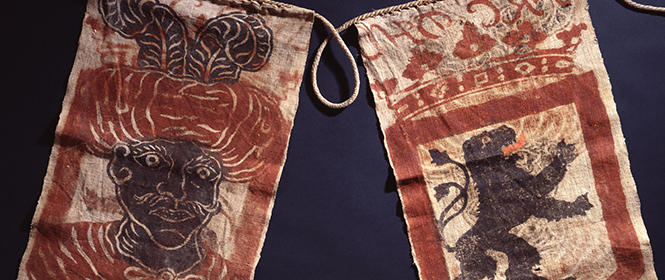
Hunting cloths
“Zum Jagen tragen” (carry to the hunt) or “Durch die Lappen gehen lassen” (let slip through the cloth) – did you know that these sayings derive from hunting practices, and reveal much about 18th-century German history? Let us take you on a historical tour of the hunt in our series “What’s That For?” we’ll explore the meaning of these sayings using selected objects from our permanent exhibition.
Princes, noblemen, statesmen: fascination with the hunt from the Middle Ages to the present
From the High Middle Ages well into the 19th century hunting both large and small game was the exclusive prerogative of the nobility, particularly princes. A culture of the hunt developed that shared similar characteristics throughout Europe, aspects of which survive to this day. In the former West Germany, for example, minister-presidents including Franz Josef Strauss and Ernst Albrecht organized large state hunting expeditions, while in the former East Germany Leonid Breschnew, Nikola Ceauscescu and Erich Honecker were known as passionate hunters who continued the tradition of princely hunts.
First and foremost the hunt served a practical purpose, providing game for the table and protecting crops by keeping the numbers of vermin in check. It quickly evolved, however, into a prestigious form of courtly culture, intentionally implemented to express princely power and sovereignty. Rulers and the nobility strove to outdo each other by hosting elaborate, expensive hunting events. Countless palatial hunting lodges in Germany speak of the popularity of the hunt, and Berlin’s Tiergarten owes its very existence to the fact that the court left the palace to hunt at every opportunity.
Over the centuries various forms of the hunt developed. The “par force” hunt represented the most “sporting” variety. The Parforceheide south of Berlin and east of Potsdam was once used for this activity, in which mounted hunters and packs of dogs hounded game all over the landscape, often for hours on end. This practice allowed the animal a real “sporting” chance to escape, and also posed a significant challenge to the hunters, who risked injury or death. As the ladies’ side-saddle in the exhibition shows, noblewomen also participated in this form of hunting.
“Durch die Lappen gehen”: the influence of the hunt on language
The “enclosed hunt” stands at the other end of the scale in terms of fairness to the animals. This type of hunting, which provided an opportunity for elaborate courtly display popular in both large and small principalities, was so widespread in Germany that it is also known as “the German hunt”. For this practice an entire area of forest was first enclosed with cloths, nets, and sheets – preparation that often took days to complete. Countless beaters then drove game into the enclosed area. The hunting party gathered in hunting blinds or roofed stands erected in a clearing or open field at one end of the hunting ground. Here ladies could also be “carried to the hunt”. Beaters, the sound of horns, and packs of dogs drove the game into the clearing, where the hunting party awaited it, armed with rifles. The game could also be “waidgerecht aufgebrochen” (properly broken up), to eat it later, in the clearing, providing it hadn’t “slipped through the cloth” and escaped out the sides of the enclosure. The entire procedure provided an excellent opportunity for a courtly festival. Stylish modern picnic dishes and wine bottles in the form of hunting rifles, as seen in our permanent exhibition, often made an appearance at such events. Two hunting cloths bearing the coat of arms of Johann Reinhard III, Count of Hanau-Lichtenberg (1665–1736), also appear in our permanent exhibition. These not only illuminate the origins of the phrase “durch die Lappen gehen”, but also bear witness to the multiple small principalities that characterized Germany in the 18th century.
Hunting implements as evidence of territorial claims and inheritance disputes
The County of Hanau-Lichtenberg, which extended from southern Hesse (Hessen) into what is now Alsace in France, was one of the many small, independent, sovereign principalities which made up the patchwork of the Holy Roman Empire. They all competed with each other and with their larger neighbours, who constantly threatened to swallow them up. Johann Reinhard III, the last Count of Hanau-Lichtenberg, died without issue, after which the neighbouring landgraves of Hessen-Kassel and Hessen-Darmstadt fought over his small country. A stack of hunting cloths bearing the coat of arms of the counts of Hanau-Lichtenberg survived in Schloss Kranichstein, which belonged to the landgraves of Hessen-Darmstadt, one of the victors in the fight over this small principality. Now in the collection of the Deutsches Historisches Museum, they stand as reminders of the history of the hunt and of 18th-century German history.